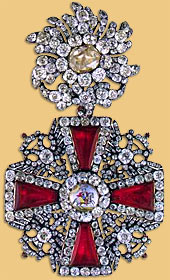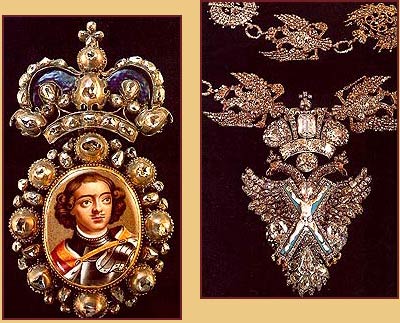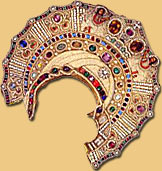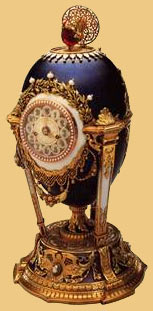 In
1719, Emperor Peter I "the Great"
(reigned 1682-1725), founded the earliest version of what we
now know as the State Diamond Fund of the Russian Federation.
Peter I had visited other European nations, and introduced many
innovations to Russia, one of which was the creation of a permanent
fund to house a collection of jewels which belonged not to the
Romanov family, but to the Russian State. In
1719, Emperor Peter I "the Great"
(reigned 1682-1725), founded the earliest version of what we
now know as the State Diamond Fund of the Russian Federation.
Peter I had visited other European nations, and introduced many
innovations to Russia, one of which was the creation of a permanent
fund to house a collection of jewels which belonged not to the
Romanov family, but to the Russian State.

Peter declared that the state holdings were inviolate,
and could not be altered, sold, or given away - and he also
decreed that each subsequent Emperor or Empress should leave
a certain number of pieces acquired during their reign to the
State, for the permanent glory of the Russian Empire. Peter
left all of the pieces used in the coronation ceremony to the
Diamond Fund, as well as many important pieces of 15th, 16th
and 17th century jewelry. The pieces were housed in a special
secure room in the Winter Palace
in St. Petersburg, first called
the Renteria, and subsequently called the Diamond Chamber.
|

Imperial Diamond Tiara.
|
 Peter's
daughter Elizabeth I (reigned 1741-1761) had a voracious taste
for jewelry, and a number of the most beautiful pieces of the
Rococo period date from her reign, such as the remarkable Earrings
in the form of garlands of flowers with bees. Peter's
daughter Elizabeth I (reigned 1741-1761) had a voracious taste
for jewelry, and a number of the most beautiful pieces of the
Rococo period date from her reign, such as the remarkable Earrings
in the form of garlands of flowers with bees.

In 1914, with the threat of a possible German invasion
due to World War I, the entire collection was carefully packed,
and sent from St. Petersburg to
Moscow, where it was placed in vaults
beneath the Kremlin for safety. But
Russia's political troubles, including the Revolution
in 1917 and the ensuing Russian Civil War made the history
of the State Jewels even more complicated.
|

Military Decoration with a potrait
of Peter The Great.
|
 The
jewels were forgotten for a time, and it was not until 1926
that they were found in the Kremlin,
and the pieces opened, catalogued, and photographed in their
entirety. An enormous selection of the pieces were sold to an
American consortium, and the pieces, which comprised close to
70% of the original collections, were sold at Christie's Auction
house in London in 1927. The pieces which were sold were dispersed
all over the globe, and many of their locations are now unknown. The
jewels were forgotten for a time, and it was not until 1926
that they were found in the Kremlin,
and the pieces opened, catalogued, and photographed in their
entirety. An enormous selection of the pieces were sold to an
American consortium, and the pieces, which comprised close to
70% of the original collections, were sold at Christie's Auction
house in London in 1927. The pieces which were sold were dispersed
all over the globe, and many of their locations are now unknown.
|

Russian Field Tiars made from Diamonds
and Gold.
|
 The
remaining pieces, which are the historically and artistically
most important from the collections include the coronation regaila,
and a spectacular collection of eighteenth and ninteenth century
jewelry. The pieces went on display for the first time in 1967
as a commemoration of the 50th Anniversary of the revolution,
when they were displayed in a special vault beneath the Kremlin
to high-ranking officials and foreign dignitaries. The
remaining pieces, which are the historically and artistically
most important from the collections include the coronation regaila,
and a spectacular collection of eighteenth and ninteenth century
jewelry. The pieces went on display for the first time in 1967
as a commemoration of the 50th Anniversary of the revolution,
when they were displayed in a special vault beneath the Kremlin
to high-ranking officials and foreign dignitaries.
The treasures of the Diamond Fund are part of the national
state heritage.
Since the fall of communism, the pieces are on display
to the public, who can buy tickets to visit the diamond fund
when they go to the Kremlin Armory
Museum in Moscow. |

|
 The
history of Russian jewelry goes back over one thousand years.
Many of the earliest pieces of Russian jewelry are very similar
in style to pieces which were worn at the court of the Byzantine
Empire. As ancient Rus' and Kiev grew into what we now know
as Russia, the style changed very little. The
history of Russian jewelry goes back over one thousand years.
Many of the earliest pieces of Russian jewelry are very similar
in style to pieces which were worn at the court of the Byzantine
Empire. As ancient Rus' and Kiev grew into what we now know
as Russia, the style changed very little.

It was not until Emperor Peter I
"the Great" that real innovations and exchanges with
the west changed Russian jewelry style for ever.
The steady influence of foreign jewelers, combined with the
Russian jewelers own creativity ended up establishing a Russian
jewelry industry of great size and importance.
|
 During
the second half of the 18th century the Russian imperial collection
of items of jewellery was being continually added to. Such pieces
included snuffboxes, which might also be used as awards or diplomatic
gifts. Catherine II herself was a passionate collector of snuffboxes
made of rare stones and was generous in her presentation of
such objects to those around her. During
the second half of the 18th century the Russian imperial collection
of items of jewellery was being continually added to. Such pieces
included snuffboxes, which might also be used as awards or diplomatic
gifts. Catherine II herself was a passionate collector of snuffboxes
made of rare stones and was generous in her presentation of
such objects to those around her.

|
|
 |
|
The Great Imperial Crown.
The Great Imperial Crown made in 1762 for the coronation
of Catherine the Great by the court jeweler J.Pauzie represents
the height of creative imagination, lavish beauty and skilled
workmanship. It is adorned with five thousand diamonds arranged
in a splendid pattern of laurel wreaths and oak branches.
The glitter of the diamonds is enhanced by two rows
of gleaming pearls and the crown is topped by a huge red
spinel, the second largest in the world, which weighs almost
400 carats.
The Scepter has the world's famous "Orlov Diamond",
the largest faceted diamond weighing 189 carats.
|

|
Faberge Collection
The 19th century brought changes in the organization
of jewelry making. Many famous jewelers worked in Russia, and
some, such as Faberge have become household names.
Peter Carl Faberge, the son of French-German ancestors,
ruled the world of jewels in the four decades prior to the outbreak
of the World War I. The House of Faberge became world-famous.
It produced inter alia, figurines made of semi-precious stones,
snuffboxes, powder-boxes and items of jewelry.
|

|
Faberge. Snuffbox, Circa
1765, Hermitage Museum.
 A
diamond-set enameled two-color gold Imperial presentation snuff-box
applied with a deep gold hued enamel over guilloche sunburst
patterns accented by Imperial eagles and defined by a gold chased
trellis set with diamonds. At the center of the box, is the
diamond-set crowned monogram of Tsar
Nicholas II against an oval panel enameled white with a
diamond-set border. A
diamond-set enameled two-color gold Imperial presentation snuff-box
applied with a deep gold hued enamel over guilloche sunburst
patterns accented by Imperial eagles and defined by a gold chased
trellis set with diamonds. At the center of the box, is the
diamond-set crowned monogram of Tsar
Nicholas II against an oval panel enameled white with a
diamond-set border.
|

A gold-and silver-mounted diamond-set
tiara, signed with initials KF for Carl Faberge.
The House of Faberge was distinguished from other jewelers
of the period by its beautifully made "Easter eggs with
a surprise". For eleven years the firm received orders
from the Imperial court for these eggs.
|
 The Lilies of the Valley egg is a masterpeace in Art
Nouveau style. The miniature of Tzar
Nicholas II and his two daughters Olga and Tatyana painted
within the body of the egg. The pictures pop up when a pearl
knob is turned.
The Lilies of the Valley egg is a masterpeace in Art
Nouveau style. The miniature of Tzar
Nicholas II and his two daughters Olga and Tatyana painted
within the body of the egg. The pictures pop up when a pearl
knob is turned.
When Kerensky's provisional government took power in February
1917, the egg was not listed in the inventory of the Imperial
Treasury. Even today it is not clear how it came to the West.
The Forbes Magazine Collection acquired it together with the
Coronation egg in 1979 for 2.16 million US dollars.
|
 Only
six of the Imperial Easter eggs contained mechanism. Only
six of the Imperial Easter eggs contained mechanism.
One of the most famous is the Rooster egg, which the ruler,
Nicholas II, presented to his mother
on April 9 1900. At the push of the button, the lid opens, and
a rooster appears, crowing and flapping his wings. The small
rooster is decorated with real feather. In 1985 the egg was
acquared by the Forbes Magazine Collection for 1.76 million
US dollars.
The Coronation Egg is enameled a deep gold hue over guilloche
sunburst patterns and blanketed by a gold trellis marked by
diamond-set Imperial eagles at the intersections.
At the top of the egg is the crowned monogram of Tsarina
Alexandra Feodorovna emblazoned
in rose-cut diamonds and rubies. The date 1897, appears beneath
a smaller portrait diamond at the bottom of the egg. When the
egg is opened, the surprise fitted inside a velvet-lined compartment
is a removable replica of a coach of gold, enamel, diamond and
rock crystal.
|
 Faberge: The Coronation Egg.
Faberge: The Coronation Egg.
Today in the museum
of Faberge you can find the most exquisite and famous works
of the house of Faberge from the Imperial Easter eggs collection
to highly luxurious items for everyday use. |
|


